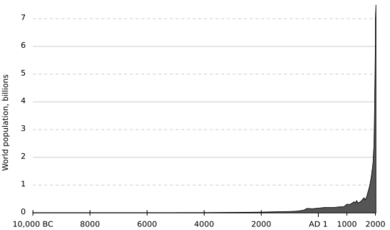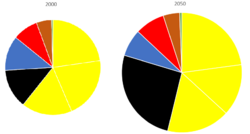Estimates of historical world population facts for kids
This article looks at how many people have lived on Earth throughout history. It also shows how the world's population has grown over time.
Estimating the world's population from long ago is very difficult. We don't have perfect records from ancient times. For example, in the year 2012, different groups estimated the world population to be around 7.02 to 7.08 billion people. This shows that even modern estimates can be slightly different.
Early Human History
The further back in time we go, the harder it is to guess how many people were alive. We only have good population numbers for the last 200-300 years. Before the late 1700s, most governments didn't count everyone accurately. Ancient counts, like in Egypt or Persia, often only counted people for taxes or military service.
For example, estimates for the year 1 AD (the start of the Common Era) vary a lot. They range from about 150 million to 330 million people. That's a big difference!
Even further back, around 10,000 BC (the early Holocene period), estimates suggest there were only about 1 to 10 million people on Earth. This was when humans were just starting to settle down and farm.
Going back even more, into the Stone Age (Paleolithic period), humans lived as hunter-gatherers. They moved around a lot to find food. At this time, modern humans lived alongside other types of humans. Scientists believe that about 70,000 years ago, after a huge volcanic eruption (the Toba catastrophe), the number of Homo sapiens (modern humans) might have dropped to as low as 1,000 to 10,000 people.
Scientists also wonder: "How many people have ever lived on Earth?" This question became popular in the 1970s when the world population was growing very fast. Some people even thought that more people were alive then than had ever died. But this was never true.
Today, experts estimate that around 100 billion people have been born since humans first appeared. This number depends on whether we count only modern humans or all early human types. It also depends on how we count babies who didn't survive long, as infant deaths were very common long ago.
World Population Growth
The world population has grown much faster since the early modern period (around the 1500s) until the 1900s. Before that, from about 500 BC to 1500 AD, the population generally grew. However, there was a big drop in the mid-1300s because of the Black Death, a terrible plague.
Here's a quick look at how the world population has changed over time:
| Year | 1400 | 1500 | 1600 | 1700 | 1800 | 1900 | 2000 | 2100 |
|---|---|---|---|---|---|---|---|---|
| population (in billions) |
0.35–0.40 | 0.43–0.50 | 0.50–0.58 | 0.60–0.68 | 0.89–0.98 | 1.56–1.71 | 6.06–6.15 | c. 10–13 |
After World War II (around 1950), we started getting much better population data. Even so, different groups might have slightly different numbers. For example, estimates from the United States Census Bureau and the United Nations Department of Economic and Social Affairs can differ by about 0.5% to 1.5%. This means that even though numbers might be shown with many digits, they are usually only accurate to about three digits.
The world population reached 1 billion people around 1804. It then grew to 2 billion by 1927, 3 billion by 1960, 4 billion by 1974, 5 billion by 1987, and 6 billion by 1999. By 2012, it reached 7 billion.
Population by World Region
The population has not grown the same way in all parts of the world. Some regions have seen much faster growth than others. For example, Asia has always had the largest share of the world's population. However, Africa's population is growing very quickly and is expected to make up a much larger share of the world's people in the future.
Here's a look at how the population has been distributed across different regions over time (numbers are in millions):
| Year | 1 | 1000 | 1500 | 1600 | 1700 | 1820 | 1913 | 2000 | 2030 |
|---|---|---|---|---|---|---|---|---|---|
| Asia | 168 | 183 | 284 | 379 | 402 | 710 | 978 | 3,605 | 4,790 |
| Europe | 34 | 40 | 78 | 112 | 127 | 224 | 498 | 742 | 829 |
| Africa | 17 | 32 | 47 | 55 | 61 | 74 | 125 | 798 | 1,449 |
| Central/South America | 6 | 11 | 18 | 9 | 12 | 22 | 81 | 520 | 702 |
| North America | 1 | 1 | 2 | 2 | 1 | 11 | 105 | 314 | 413 |
| Oceania | 0.4 | 0.4 | 0.6 | 0.6 | 0.6 | 0.4 | 5 | 23 | 28 |
| World Total | 226 | 267 | 438 | 556 | 603 | 1,041 | 1,791 | 6,062 | 8,175 |



